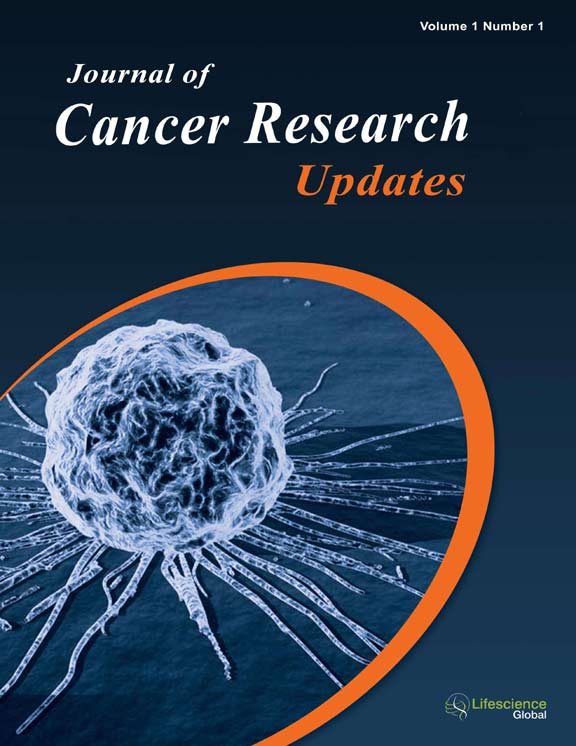jcru
Editor’s Choice : The Reciprocal Interaction of Small Molecule Protein Kinase Inhibitors and ATP-Binding Cassette Transporters in Targeted Cancer Therapy
|
|
Abstract: Protein kinaseshave become the second most important group of drug targets, after G-protein-coupled receptors. Currently,15 small molecule protein kinase inhibitors (PKIs) have received food and drug administrator (FDA) approval to be used as cancer treatments. However, in the course of clinical use of these small molecule PKIs, drug resistance has become a recurring problem. Their therapeutic potential depends on access to their intracellular targets, which significantly affected by certain membrane ATP-binding cassette(ABC) transporters. ABC transporters were major causesof clinical multiple drug resistance (MDR) and might be resulting in the development of resistance to PKIs in cancer patients. Some PKIs could modulate the activity of ABC transporters and affect the metabolism of themselves and other chemically unrelated drugs. Moreover, it has been recently reported that some PKIs could regulate the expression of ABC transporters in tumor cells, thereby affect their intracellular accumulation and antitumor efficacy. In this review,the reciprocal interaction of clinically important PKIs with the MDR-related ABC transporters, in particular ABCB1 and ABCG2,wassummarized. Keywords: Protein Kinase Inhibitors, ABC Transporters, P-gp/ABCB1, BCRP/ABCG2, Targeted Cancer Therapy.Download Full Article |
Editor’s Choice : TRAP1 is Involved in Cell Cycle Regulated by Retinoblastoma Susceptibility Gene (RB1) in Early Hypoxia and has Variable Expression Patterns in Human Tumors
|
|
Abstract: Tumor necrosis factor receptor associated protein 1(TRAP1) is a member of the Hsp90 family that acts as a molecular chaperon to the tumor suppressor retinoblastoma susceptibility gene (RB1). We have previously demonstrated that TRAP1-positive cells contain a high level of cell proliferating genes, whilst TRAP1-negative cells contain a high level of genes involved in cell cycles and metastases. In this study, we performed a functional analysis of TRAP1 which focused on its regulation within a cell cycle in relation to RB1. Following a heat shock, TRAP1 translocates to the nucleus and chaperonsRB1. When TRAP1 is silenced by siRNA, or prevented from entering the nucleus in hypoxic cells, formation of RB1/E2F1 complexes is impaired and cell cycle activity is promoted by deregulating the G1/S transition. Inhibition of the nuclear translocation of TRAP1 with geldanamycin abrogates its ability to maintain RB1 in a form that associates with E2F1. Restoration of TRAP1 expression reverses these effects. We analysed TRAP1/RB1 expression on 630 tumors by immunohistochemical staining and found TRAP1 lost in some types of cancer, such as non-small cell lung cancer and breast cancer, and the positive correlation of TRAP1 expression in nuclear and cytoplasm with RB1 was observed. Clinico-pathological data showed that breast carcinoma patients lacking nuclear TRAP1 have a shorter disease free survival. Our data suggests that nuclear translocation of TRAP1 is crucial for its function as a chaperon. The loss of TRAP1 expression in certain types of cancer may provide the growth advantage due to the lost control at cell cycle check point. Keywords: TRAP1, RB1, cell cycle, chaperon, hypoxia.Download Full Article |
Editor’s Choice Potential Solutions in Radiation Hormesis
|
|
Abstract: This study summarizes up-to-date information about the biopositive effects of low radiation treatment (LRT), radiation hormesis, and our experimental devices. In addition, we present a favorable treatment result in a patient with advanced rectal carcinoma who received LRT at home using a radon gas aspirator. The patient was a 61-year-old man who underwent proctectomy in 2010. During the additional first-line chemotherapy, apparent increases in tumor makers identified multiple remote metastases in the lung, sacrum and liver. Sacrum pain limited his activity of daily living and impeded his coming to our facility for LRT. Then, we decided to provide him home LRT using a radon gas aspirator. He inhaled radon gas for 15 minutes at least 3 times a day at home, resulting in remarkably reduced tumor markers and sacrum pain relief. He could walk, keep sitting up without support and sleep in the spine position again after receiving home LRT. No influence of radon gas inhalation on the second-line chemotherapy was observed. The favorable effects of LRT lead us to believe that the newly-developed devices will provide the clinical significance on malignant diseases. To establish the LRT regimen, further clinical investigation and data accumulation are thus called for. Keywords: Alternative treatment, low radiation treatment, radon gas, malignant diseases.Download Full Article |
Editor’s Choice : Vemurafenib (PLX4032, Zelboraf®), a BRAF Inhibitor, Modulates ABCB1-, ABCG2-, and ABCC10-Mediated Multidrug Resistance
|
|
Abstract: In this study, we examined the in vitro effects of vemurafenib, a specific inhibitor of V600E mutated BRAF enzyme, on the response of cells overexpressing the ATP binding cassette (ABC) efflux transporters ABCG2, ABCB1, ABCC1 and ABCC10. Vemurafenib, at 5 µM and 20 µM, produced a significant concentration-dependent increase in the cytotoxicity of paclitaxel in cells overexpressing ABCB1 and ABCC10 and mitoxantrone in cells overexpressing ABCG2. Vemurafenib also significantly enhanced the accumulation of paclitaxel in cell lines overexpressing ABCB1 and ABCC10. Vemurafenib significantly increased the intracellular accumulation of mitoxantrone in cells overexpressing ABCG2. In contrast, vemurafenib did not significantly alter the sensitivity of ABCC1 overexpressing HEK/ABCC1 cells to vincristine. Finally, as determined by Western blotting, vemurafenib (20 µM) did not significantly alter the expression of the proteins for ABCG2, ABCC10 or ABCB1. Thus, vemurafenib most likely reverses multidrug resistance by altering the transport function of these aforementioned ABC transporters, as opposed to affecting the expression of ABC proteins. The docking analysis of vemurafenib with the ABCB1 homology model also suggested that vemurafenib binds to the ABCB1 and ABCG2 drug binding site. These findings suggest that combination of specific inhibitors like vemurafenib with chemotherapeutic drugs may be used to overcome multidrug resistance in cells that overexpress ABCB1, ABCC10 and/or ABCG2 transporters. Keywords: Vemurafenib, ABCC10, ABCG2, MDR.Download Full Article |



